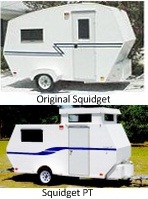Regarding building the chassis for my Squidget, as I mentioned before, a son-in-law is a welder and I am thinking about building my own 5'x9' chassis...that is, my design with my son-in-law doing the welding. But, one of my concerns is placement of the axle for proper balance. I have a local trailer builder that I plan on talking to for advice, but maybe some of you have some expertise in this area.
Here is my current ideas as to the solution to this problem. I’m thinking of doing the following: First, put the finished chassis sans axle on 6"-8” high blocks. Then, place all of the trailer building materials on the chassis, trying to distribute them in the approximate locations where they will be installed (plywood floors, sides, top; framing lumber; battery; even the AC unit and a bag of topsoil to represent the filled water tank).
After all is on the chassis, first, I can weigh the trailer at 3 points, each side and tongue so that I’ll get a rough idea of the finished weight. Then, I'll lower the chassis onto a piece of 4" PVC placed side to side under the chassis, just back of center (and hope the PVC isn't crushed). Then, place a scale under the hitch. I will roll the chassis forward or back on the PVC until I have about 100 lbs "tongue weight". Once the tongue weight is at 100 lbs, I’ll mark the center point for the axle where the PVC ends up. Does this sound plausible? Any comments or suggestions on this technique?
This is where I need technical info from professionals or any of you who have done it already. Is 100 lbs tongue weight about right? Or should it be more? (My bass boat is about 250 lbs at the hitch). If it helps, I estimate now that the entire trailer will weigh between 1100 and 1300 lbs. I want the axle positioned far enough back to track well (no side-to-side sway) when being towed. The farther back the axle is, the better it should track, so maybe more than 100 lbs tongue weight would be advisable. I know that when I load the trailer for camping, most of the weight will in the under bed storage compartments over the axle, but some will be in the front closet and galley cabinet, so the tongue weight may increase slightly after loading equipment and supplies. I have a draw hitch that will support up to 300 lbs tongue weight.
I am also thinking of using the torsion axle rather than springs. I want as smooth a ride as possible. Here's why. My AC will be mounted high in the rear of the cabin and no matter how well I brace it, hard jolts might loosen it and cause leaks. I know from posts that some don't think there is much of a difference, but I think the torsion ride will be added insurance against problems.
Dale
Chassis construction, more questions...
11 posts
• Page 1 of 1
Chassis construction, more questions...
Dale
Sometimes I pretend to be normal. But, that gets boring...so I go back to being me.
Squidget Pop Top Build Pages http://www.thesquidget.com/ptbuild/ptbuild.html
Squidget and Pop Top Plans Info and Photos: http://www.TheSquidget.com
Sometimes I pretend to be normal. But, that gets boring...so I go back to being me.
Squidget Pop Top Build Pages http://www.thesquidget.com/ptbuild/ptbuild.html
Squidget and Pop Top Plans Info and Photos: http://www.TheSquidget.com
-

cracker39 - 3000 Club

- Posts: 3069
- Images: 233
- Joined: Thu Jun 30, 2005 2:18 pm
- Location: Lake Alfred, Florida, USA
NT Torsion Kits?
Northern Tool has torsion axel suspension units for 139.99. This doesn't appear to be a whole axle, just the torsion units. It looks like they weld onto the side rails of the chassis. Does anyone know anything about this system?
http://www.northerntool.com/webapp/wcs/ ... te=trailer
They also sell the high speed hub sets for $41.99. That would be about the price as a standard spring axle set.
http://www.northerntool.com/webapp/wcs/ ... te=trailer
They also sell the high speed hub sets for $41.99. That would be about the price as a standard spring axle set.
Dale
Sometimes I pretend to be normal. But, that gets boring...so I go back to being me.
Squidget Pop Top Build Pages http://www.thesquidget.com/ptbuild/ptbuild.html
Squidget and Pop Top Plans Info and Photos: http://www.TheSquidget.com
Sometimes I pretend to be normal. But, that gets boring...so I go back to being me.
Squidget Pop Top Build Pages http://www.thesquidget.com/ptbuild/ptbuild.html
Squidget and Pop Top Plans Info and Photos: http://www.TheSquidget.com
-

cracker39 - 3000 Club

- Posts: 3069
- Images: 233
- Joined: Thu Jun 30, 2005 2:18 pm
- Location: Lake Alfred, Florida, USA


 That tinyurl link sure is great though.
That tinyurl link sure is great though.


